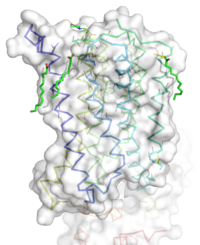Sandbox Reserved 1160
From Proteopedia
(Difference between revisions)
| Line 1: | Line 1: | ||
== Human metabotropic glutamate receptor 5 transmembrane domain == | == Human metabotropic glutamate receptor 5 transmembrane domain == | ||
<StructureSection load='4oo9' size='350' frame='true' side='right' caption='Human metabotropic glutamate receptor 5 transmembrane domain' <'scene='(Ionic_lock)'> | <StructureSection load='4oo9' size='350' frame='true' side='right' caption='Human metabotropic glutamate receptor 5 transmembrane domain' <'scene='(Ionic_lock)'> | ||
| - | Receiving and responding to extracellular messages is critical to the proper function of the nervous system. Glutamate is the major excitory neurotransmitter of the CNS, and metabotropic glutamate receptor 5 will play a major role in glutamate signaling. Metabotropic glutamate receptor 5 transmembrane domain is a homodimeric GPCR that resides in the cellular membrane <ref name="Dore" />. This domain is a member of the Class C GPCR family and can further be categorized into the Group I subgroup. The transmembrane domain will signal through a Gq/11 pathway. mGlu5 will bind glutamate to the extracellular Venus flytrap domain and the signal will be transduced across the membrane to a heterotrimeric G protein, which will ultimately lead to calcium release and activation of PKC. This will elicit a excitory post-synaptic repose and modulate long term potentiation. Human metabotropic glutamate receptor 5 is found throughout the central nervous system. Areas containing high concentrations of this protein are often involved involved in emotions and higher cognition. The localization of mGlu5 in the CNS and the presence of multiple domains makes mGlu5 a possible target for treating schizophrenia, Fragile X, depression, anxiety,and Alzheimer's disease. | + | Receiving and responding to extracellular messages is critical to the proper function of the nervous system. Glutamate is the major excitory neurotransmitter of the CNS, and metabotropic glutamate receptor 5 will play a major role in glutamate signaling. Metabotropic glutamate receptor 5 transmembrane domain is a homodimeric GPCR that resides in the cellular membrane <ref name="Dore" />. This domain is a member of the Class C GPCR family and can further be categorized into the Group I subgroup. The transmembrane domain will signal through a Gq/11 pathway. mGlu5 will bind glutamate to the extracellular Venus flytrap domain and the signal will be transduced across the membrane to a heterotrimeric G protein, which will ultimately lead to calcium release and activation of PKC. This will elicit a excitory post-synaptic repose and modulate long term potentiation. Human metabotropic glutamate receptor 5 is found throughout the central nervous system. Areas containing high concentrations of this protein are often involved involved in emotions and higher cognition<ref name="Wu" />. The localization of mGlu5 in the CNS and the presence of multiple domains makes mGlu5 a possible target for treating schizophrenia, Fragile X, depression, anxiety,and Alzheimer's disease<ref name="Wu" />. |
== Discovery == | == Discovery == | ||
| - | The mGlu family of receptors was the first of the Class C GPCR to be extensively studied. The first regions of the protein crystallized and studied were the Venus fly trap domain and the cystiene-rich domain on the extracellular region of the receptor. The hydrophobic nature and flexibility of the transmembrane domain made it difficult to crystalize. Recently, the human metabotropic glutamate receptor 5 transmembrane domain was crystallized and a structure elucidated. There were several modifications that had to be made to the TMD for it to successfully crystallize. The protein was thermostabilized and flexible domains were removed. In total residue 2-568 and residues 837-1153 were excised from the structure. Also, a T4 -<scene name='72/721531/Protien_lys/1'>Lysozyme</scene> was inserted into ICL-2. | + | The mGlu family of receptors was the first of the Class C GPCR to be extensively studied<ref name="Wu" />. The first regions of the protein crystallized and studied were the Venus fly trap domain and the cystiene-rich domain on the extracellular region of the receptor. The hydrophobic nature and flexibility of the transmembrane domain made it difficult to crystalize. Recently, the human metabotropic glutamate receptor 5 transmembrane domain was crystallized and a structure elucidated. There were several modifications that had to be made to the TMD for it to successfully crystallize. The protein was thermostabilized and flexible domains were removed. In total residue 2-568 and residues 837-1153 were excised from the structure. Also, a T4 -<scene name='72/721531/Protien_lys/1'>Lysozyme</scene> was inserted into ICL-2. |
== Structure== | == Structure== | ||
[[Image:STR.png|200 px|left|thumb|Figure Legend]] | [[Image:STR.png|200 px|left|thumb|Figure Legend]] | ||
| Line 33: | Line 33: | ||
== References == | == References == | ||
<ref name="Dore">PMID: 25042998</ref> | <ref name="Dore">PMID: 25042998</ref> | ||
| + | <ref name="Wu">PMID: 24603153</ref> | ||
<references/> | <references/> | ||
== External Resources == | == External Resources == | ||
Revision as of 11:31, 29 March 2016
Human metabotropic glutamate receptor 5 transmembrane domain
| |||||||||||
References
- ↑ 1.0 1.1 Dore AS, Okrasa K, Patel JC, Serrano-Vega M, Bennett K, Cooke RM, Errey JC, Jazayeri A, Khan S, Tehan B, Weir M, Wiggin GR, Marshall FH. Structure of class C GPCR metabotropic glutamate receptor 5 transmembrane domain. Nature. 2014 Jul 31;511(7511):557-62. doi: 10.1038/nature13396. Epub 2014 Jul 6. PMID:25042998 doi:http://dx.doi.org/10.1038/nature13396
- ↑ 2.0 2.1 2.2 2.3 Wu H, Wang C, Gregory KJ, Han GW, Cho HP, Xia Y, Niswender CM, Katritch V, Meiler J, Cherezov V, Conn PJ, Stevens RC. Structure of a class C GPCR metabotropic glutamate receptor 1 bound to an allosteric modulator. Science. 2014 Apr 4;344(6179):58-64. doi: 10.1126/science.1249489. Epub 2014 Mar , 6. PMID:24603153 doi:http://dx.doi.org/10.1126/science.1249489

